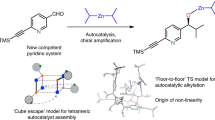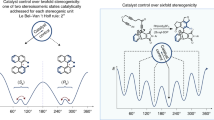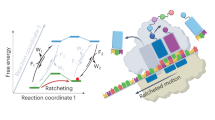Abstract
Selectivity in chemical reactions that form complex molecular architectures from simpler precursors is usually rationalized by comparing competing transition-state structures that lead to different possible products. Herein we describe a system for which a single transition-state structure leads to the formation of many isomeric products via pathways that feature multiple sequential bifurcations. The reaction network described connects the pimar-15-en-8-yl cation to miltiradiene, a tricyclic diterpene natural product, and isomers via cyclizations and/or rearrangements. The results suggest that the selectivity of the reaction is controlled by (post-transition-state) dynamic effects, that is, how the carbocation structure changes in response to the distribution of energy in its vibrational modes. The inherent dynamical effects revealed herein (characterized through quasiclassical direct dynamics calculations using density functional theory) have implications not only for the general principles of selectivity prediction in systems with complex potential energy surfaces, but also for the mechanisms of terpene synthase enzymes and their evolution. These findings redefine the challenges faced by nature in controlling the biosynthesis of complex natural products.
This is a preview of subscription content, access via your institution
Access options
Subscribe to this journal
Receive 12 print issues and online access
$259.00 per year
only $21.58 per issue
Buy this article
- Purchase on Springer Link
- Instant access to full article PDF
Prices may be subject to local taxes which are calculated during checkout






Similar content being viewed by others
References
Davis, E. M. & Croteau, R. Cyclization enzymes in the biosynthesis of monoterpenes, sesquiterpenes, and diterpenes. Top. Curr. Chem. 209, 53–95 (2000).
Cane, D. E. Enzymatic formation of sesquiterpenes. Chem. Rev. 90, 1089–1103 (1990).
Christianson, D. W. Structural biology and chemistry of terpenoid cyclases. Chem. Rev. 106, 3412–3442 (2006).
Miller, D. J. & Allemann, R. K. Sesquiterpene synthases: passive catalysts or active players? Nat. Prod. Rep. 29, 60–71 (2012).
Gao, W., et al. A functional genomics approach to tanshinone biosynthesis provides stereochemical insights. Org. Lett. 11, 5170–5173 (2009).
Zhou, Y. J. et al. Modular pathway engineering of diterpenoid synthases and the mevalonic acid pathway for miltiradiene production. J. Am. Chem. Soc. 134, 3234–3241 (2012).
Ess, D. H. et al. Bifurcations on potential energy surfaces of organic reactions. Angew. Chem. Int. Ed. 47, 7592–7601 (2008).
Thomas, J. B., Waas, J. R., Harmata, M. & Singleton, D. A. Control elements in dynamically determined selectivity on a bifurcating surface. J. Am. Chem. Soc. 130, 14544–14555 (2008).
Birney, D. M. Theory, experiment and unusual features of potential energy surfaces of pericyclic and pseudopericyclic reactions with sequential transition structures. Curr. Org. Chem. 14, 1658–1668 (2010).
Hansen J. H. et al. On the mechanism and selectivity of the combined C−H activation/Cope rearrangement. J. Am. Chem. Soc. 133, 5076–5085 (2011).
Quapp, W. How does a reaction path branching take place? A classification of bifurcation events. J. Molec. Struc. 695-696, 95–101 (2004).
Rehbein, J. & Carpenter, B. K. Do we fully understand what controls chemical selectivity? Phys. Chem. Chem. Phys. 13, 20906–20922 (2011).
Hong, Y. J. & Tantillo, D. J. A potential energy surface bifurcation in terpene biosynthesis. Nature Chem. 1, 384–389 (2009).
Siebert, M. R., Zhang, J., Addepalli, S. V., Tantillo, D. J. & Hase, W. L. The need for enzymatic steering in abietic acid biosynthesis: gas-phase chemical dynamics simulation of carbocation rearrangements on a bifurcating potential energy surface. J. Am. Chem. Soc. 133, 8335–8343 (2011).
Siebert, M. R., Manikandan, P., Sun, R., Tantillo, D. J. & Hase, W. L. Gas-phase chemical dynamics simulations on the bifurcating pathway of the pimaradienyl cation rearrangement. Role of enzymatic steering in abietic acid biosynthesis. J. Chem. Theor. Comput. 8, 1212–1222 (2012).
Tao, P., Gatti, D. L. & Schlegel, H. B. The energy landscape of 3-deoxy-D-manno-octulosonate 8-phosphate synthase. Biochemistry 48, 11706 (2009).
Carpenter, B. K. Intramolecular dynamics for the organic chemist. Acc. Chem. Res. 25, 520–528 (1992).
Black, K., Liu, P., Xu, L., Doubleday, C. & Houk, K. N. Dynamics, transition states, and timing of bond formation in Diels–Alder reactions. Proc. Natl Acad. Sci. USA 109, 12860–12865 (2012).
Bogle, X. S. & Singleton, D. A. Dynamic origin of the stereoselectivity of a nucleophilic substitution reaction. Org. Lett. 14, 2528–2531 (2012).
Paranjothy, M., Sun, R., Zhuang, Y. & Hase, W. L. Direct chemical dynamics simulations: coupling of classical and quasiclassical trajectories with electronic structure theory. WIREs Comput. Mol. Sci. 3, 296–316 (2013).
Marx, D. & Hutter, J. Ab Initio Molecular Dynamics: Basic Theory and Advanced Methods (Cambridge Univ. Press, 2009).
Allemann, R. K., Young, N. J., Ma, S., Truhlar, D. G. & Gao, J. Synthetic efficiency in enzyme mechanisms involving carbocations: aristolochene synthase. J. Am. Chem. Soc. 129, 13008–13013 (2007).
Glowacki, D. R., Liang, C. H., Marsden, S. P., Harvey, J. N. & Pilling, M. J. Alkene hydroboration: hot intermediates that react while they are cooling. J. Am. Chem. Soc. 132, 13621–13623 (2010).
Zheng, J., Papajak, E. & Truhlar, D. G. Phase space prediction of product branching ratios: canonical competitive nonstatistical model. J. Am. Chem. Soc. 131, 15754–15760 (2009).
Vaughan, M. M., et al. Formation of the unusual semivolatile diterpene rhizathalene by the Arabidopsis Class I terpene synthase TPS08 in the root stele is involved in defense against belowground herbivory. Plant Cell 25, 1108–11025 (2013).
Gutierrez, O. & Tantillo, D. J. Analogies between synthetic and biosynthetic reactions in which [1,2]-alkyl shifts are combined with other events – dyotropic, Schmidt and carbocation rearrangements. J. Org. Chem. 77, 8845–8850 (2012).
Zhou, K. & Peters, R. J. Electrostatic effects on (di)terpene synthase product outcome. Chem. Commun. 47, 4074–4080 (2011).
Tantillo, D. J. The carbocation continuum in terpene biosynthesis – where are the secondary cations? Chem. Soc. Rev. 39, 2847–2854 (2010).
Tantillo, D. J. Biosynthesis via carbocations: theoretical studies on terpene formation. Nat. Prod. Rep. 28, 1035–1053 (2011).
Sheppard, A. N. & Acevedo, O. Multidimensional exploration of valley-ridge inflection points on potential-energy surfaces. J. Am. Chem. Soc. 131, 2530–2540 (2009).
Karplus, M., Porter, R. N. & Sharma, R. D. Exchange reactions with activation energy. I. Simple barrier potential for (H, H2). J. Chem. Phys. 43, 3259 (1965).
Aue, D. Bifurcation on reaction pathways for pinacol-type rearrangements. 33rd Reaction Mechanisms Conference, University of Massachusetts, Amherst, 23–26 June (2010).
Townsend, D. et al. The roaming atom: straying from the reaction path in formaldehyde decomposition. Science 306, 1158–1161 (2004).
Bowman, J. M. & Suits, A. G. Roaming reactions: the third way. Phys. Today 64, 33 (November 2011).
Ammal, S. C., Yamataka, H., Aida, M. & Dupuis, M. Dynamics-driven reaction pathway in an intramolecular rearrangement. Science 299, 1555–1557 (2003).
Frisch, M. J. et al. Gaussian03, revision D.01 (Gaussian, Pittsburgh, Pennsylvania, 2003).
Frisch, M. J. et al. Gaussian09, revision A.02 (Gaussian, Pittsburgh, Pennsylvania, 2009).
Becke, A. D. Density-functional thermochemistry. 3. The role of exact exchange. J. Chem. Phys. 98, 5648–5652 (1993).
Becke, A. D. A new mixing of Hartree–Fock and local density-function theories. J. Chem. Phys. 98, 1372–1377 (1993).
Lee, C., Yang, W. & Parr, R. G. Development of the Colle–Salvetti correlation-energy formula into a functional of the electron density. Phys. Rev. B 6, 785–789 (1988).
Stephens, P. J., Devlin, F. J., Chabalowski, C. F. & Frisch, M. J. Ab initio calculation of vibrational absorption and circular-dichroism spectra using density-functional force-fields. J. Phys. Chem. 98, 11623–11627 (1994).
Matsuda, S. P. T. et al. Mechanistic insights into triterpene synthesis from quantum mechanical calculations. Detection of systematic errors in B3LYP cyclization energies. Org. Biomol. Chem. 4, 530–543 (2006).
Zhao, Y. & Truhlar, D. G. Hybrid meta density functional theory methods for thermochemistry, thermochemical kinetics, and noncovalent interactions: the MPW1B95 and MPWB1K models and comparative assessments for hydrogen bonding and van der Waals interactions. J. Phys. Chem. A 108, 6908–6918 (2004).
Zheng, J., Zhao, Y. & Truhlar, D. G. Representative benchmark suites for barrier heights of diverse reaction types and assessment of electronic structure methods for thermochemical kinetics. J. Chem. Theory Comput. 3, 569–582 (2007).
Fukui, K. The path of chemical reactions – the IRC approach. Acc. Chem. Res. 14, 363–368 (1981).
Gonzalez, C. & Schlegel, H. B. Reaction path following in mass-weighted internal coordinates. J. Phys. Chem. 94, 5523–5527 (1990).
Müller, N., Falk, A. & Gsaller, G. Ball & Stick V.4.0a12, Molecular Graphics Application for MacOS Computers (Johannes Kepler University, Linz, 2004).
Kelly, K. K., Hirschi, J. S. & Singleton, D. A. Newtonian kinetic isotope effects. Observation, prediction, and origin of heavy-atom dynamic isotope effects. J. Am. Chem. Soc. 131, 8382–8383 (2009).
Wang, Z., Hirschi, J. S. & Singleton, D. A. Dynamic matching effects on selectivity in a Diels–Alder reaction, Angew. Chem. Int. Ed. 48, 9156–9159 (2009).
Acknowledgements
This work was supported by the US National Science Foundation (CHE-0957416 and supercomputing resources through a grant from the XSEDE program: CHE030089). We also thank R. Pemberton for his advice and assistance in running dynamics calculations, R. Peters for encouraging us to investigate the biosynthesis of miltiradiene, D. Singleton for sharing his Progdyn program, J. Baek for technical assistance with data analysis and J. Lee and M. Lodewyk for helpful comments.
Author information
Authors and Affiliations
Contributions
Y.J.H. and D.J.T. conceived and designed the project, Y.J.H. carried out the calculations, Y.J.H and D.J.T. analysed and interpreted the results, Y.J.H. designed the figures with assistance from D.J.T. and D.J.T. wrote the manuscript with assistance from Y.J.H.
Corresponding author
Ethics declarations
Competing interests
The authors declare no competing financial interests.
Supplementary information
Supplementary information
Supplementary information (PDF 6362 kb)
Supplementary information
Supplementary movie 1 (MOV 1856 kb)
Supplementary information
Supplementary movie 2 (MOV 3130 kb)
Supplementary information
Supplementary movie 3 (MOV 3999 kb)
Supplementary information
Supplementary movie 4 (MOV 15133 kb)
Supplementary information
Supplementary movie 5 (MOV 14456 kb)
Supplementary information
Supplementary movie 6 (MOV 12249 kb)
Supplementary information
Supplementary movie 7 (MOV 6144 kb)
Supplementary information
Supplementary movie 8 (MOV 9743 kb)
Rights and permissions
About this article
Cite this article
Hong, Y., Tantillo, D. Biosynthetic consequences of multiple sequential post-transition-state bifurcations. Nature Chem 6, 104–111 (2014). https://doi.org/10.1038/nchem.1843
Received:
Accepted:
Published:
Issue Date:
DOI: https://doi.org/10.1038/nchem.1843
This article is cited by
-
Catalytic role of carbonyl oxygens and water in selinadiene synthase
Nature Catalysis (2022)
-
Reaction Space Projector (ReSPer) for Visualizing Dynamic Reaction Routes Based on Reduced-Dimension Space
Topics in Current Chemistry (2022)
-
Unusual KIE and dynamics effects in the Fe-catalyzed hetero-Diels-Alder reaction of unactivated aldehydes and dienes
Nature Communications (2020)
-
Enzyme-catalysed [6+4] cycloadditions in the biosynthesis of natural products
Nature (2019)
-
SAM-dependent enzyme-catalysed pericyclic reactions in natural product biosynthesis
Nature (2017)



